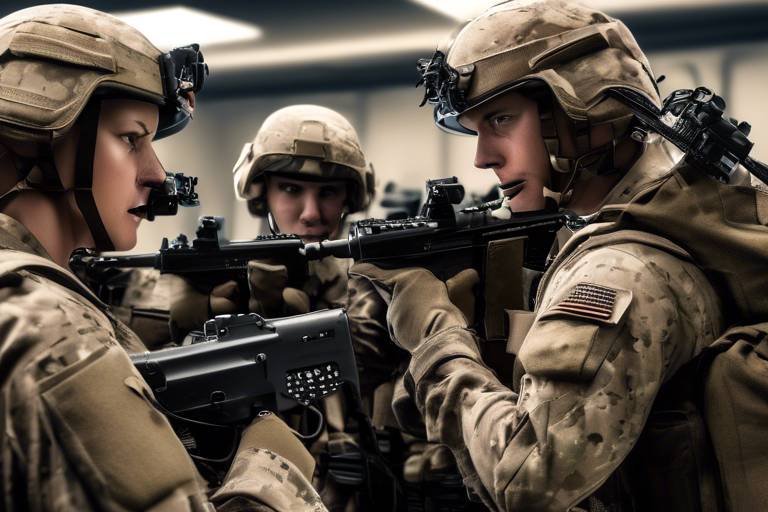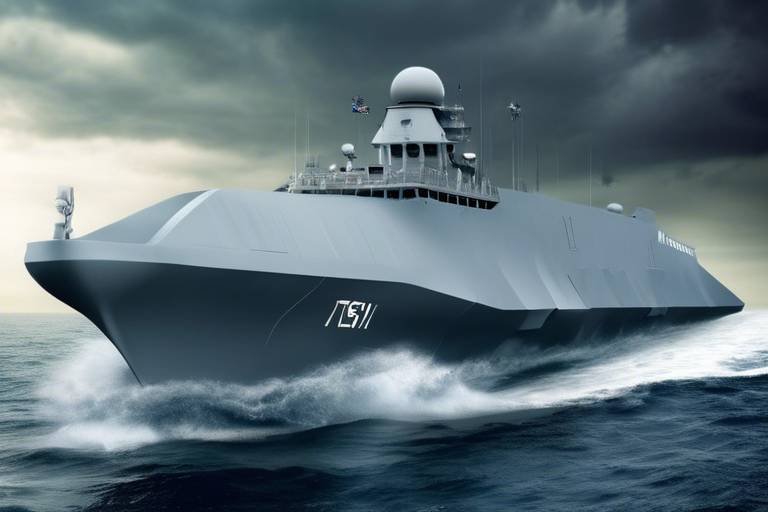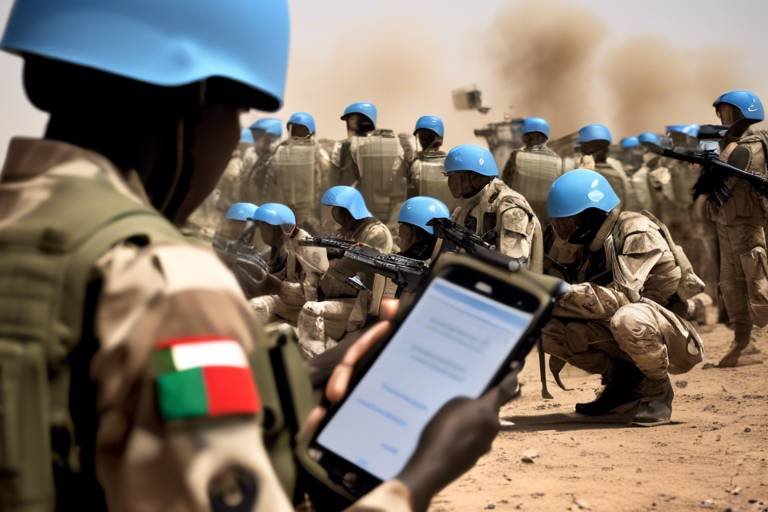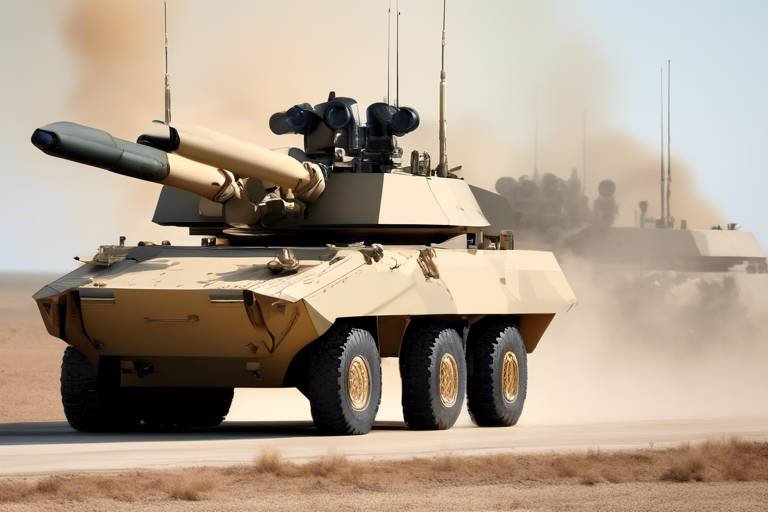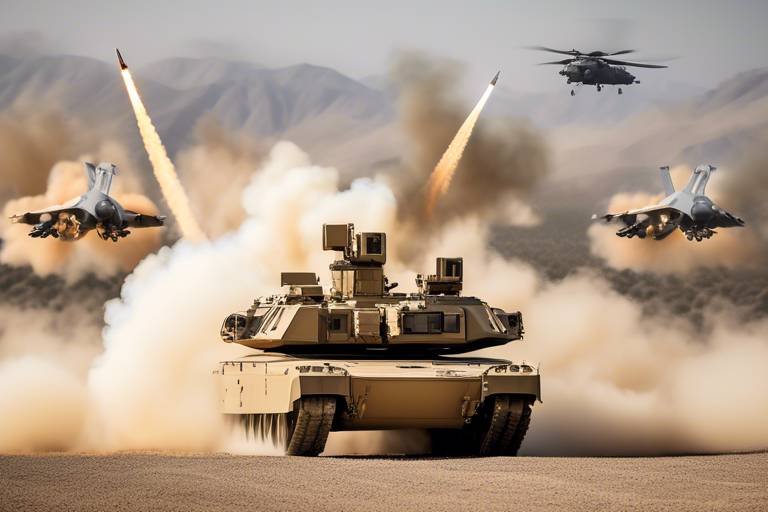The Importance of Cyber Defense in Protecting Military Assets
In today’s digital age, where technology governs almost every aspect of our lives, the military is not exempt from the vulnerabilities that come with it. The importance of cyber defense in protecting military assets cannot be overstated. Just imagine a battlefield where traditional warfare tactics are overshadowed by cyber attacks that can cripple communication systems, disrupt logistics, and even compromise sensitive data. It’s a reality that military organizations worldwide are grappling with as they strive to safeguard their operations against increasingly sophisticated cyber threats.
Cyber defense is not merely an IT issue; it's a matter of national security. The stakes are incredibly high—an effective cyber attack on military infrastructure could lead to catastrophic consequences. Therefore, understanding the critical role of cyber defense becomes essential. This involves recognizing the types of threats that exist in the cyber landscape, from state-sponsored hacking to ransomware attacks targeting military networks. Each of these threats poses unique challenges that demand strategic responses.
Moreover, as military operations become more interconnected and reliant on technology, the potential for cyber vulnerabilities increases. The integration of advanced technologies, while beneficial, also opens new doors for adversaries to exploit. Thus, military organizations must adopt a proactive stance, continuously evolving their cyber defense mechanisms to stay one step ahead of potential threats. This is not just about installing firewalls or antivirus software; it's about creating a comprehensive cyber defense strategy that encompasses risk management, incident response, and continuous monitoring.
In this article, we will delve deeper into the strategies and challenges surrounding military cyber defense. We will explore how risk assessments can help identify vulnerabilities, the significance of incident response planning, and the necessity of continuous monitoring and threat intelligence. Furthermore, we will discuss the human element in cyber defense—how training and awareness programs can empower military personnel to recognize and respond to cyber threats effectively.
As we navigate through these topics, it becomes clear that collaboration with the private sector is also essential. By partnering with technology companies, military organizations can leverage advanced tools and resources that enhance their cyber defense capabilities. The sharing of best practices and the adoption of emerging technologies like AI and machine learning can further bolster military cybersecurity efforts.
In conclusion, the need for robust cyber defense in protecting military assets is more pressing than ever. With the evolving nature of cyber threats, military organizations must remain vigilant and adaptable, ensuring that they are equipped to face the challenges of modern warfare head-on. As we continue to explore this vital topic, let’s keep in mind that the future of military operations may very well depend on how effectively we can defend against cyber threats.
- What are the main types of cyber threats faced by the military? The military faces various threats including state-sponsored hacking, ransomware, phishing attacks, and insider threats.
- How can military organizations assess their cyber risks? Conducting thorough risk assessments that identify vulnerabilities and potential impacts is crucial for effective cyber defense.
- What role does training play in military cyber defense? Training and awareness programs are essential to equip military personnel with the skills to recognize and respond to cyber threats.
- How can the military collaborate with the private sector? By forming partnerships with technology companies, the military can access advanced tools and share best practices to enhance cybersecurity.

The Evolving Cyber Threat Landscape
The digital battlefield is constantly shifting, and understanding this evolving cyber threat landscape is crucial for military organizations. As technology advances, so do the tactics employed by adversaries. Cyber threats have transformed from simple hacking attempts to sophisticated attacks that can cripple entire military operations. Imagine a scenario where an enemy can disable communication systems or manipulate weapon systems remotely—this is not science fiction; it's a reality we face today.
One of the most pressing threats is the rise of state-sponsored cyber attacks. These are not just random acts of malice but calculated strategies aimed at destabilizing countries. For instance, nation-states are increasingly investing in cyber warfare capabilities, employing teams of skilled hackers to infiltrate military networks. The implications for national security are profound, as these attacks can lead to the theft of sensitive data, disruption of operations, and even loss of life.
Moreover, the emergence of ransomware attacks adds another layer of complexity. Cybercriminals are now targeting military assets with the intent to lock down critical systems until a ransom is paid. This not only poses a financial risk but can also compromise mission readiness. The potential for a multi-faceted attack—where ransomware is used alongside other tactics—makes it imperative for military organizations to be on high alert.
In addition to these threats, we must also consider the vulnerabilities inherent in legacy systems. Many military operations still rely on outdated technology that is not equipped to handle modern cyber threats. This reliance can create a dangerous gap in defense capabilities, making it easier for adversaries to exploit weaknesses. The challenge lies in balancing the need for advanced technology with the realities of budget constraints and operational requirements.
Furthermore, the proliferation of the Internet of Things (IoT) has introduced new vulnerabilities. With more devices connected to networks, the attack surface for cyber threats has expanded dramatically. Military assets, from drones to communication devices, can potentially be compromised if proper security measures are not implemented. This interconnectedness means that a breach in one area can lead to cascading failures across multiple systems.
To illustrate the variety of cyber threats faced by military organizations, consider the following table:
| Type of Threat | Description | Potential Impact |
|---|---|---|
| State-Sponsored Attacks | Coordinated efforts by nation-states to infiltrate military networks. | Data theft, operational disruption, and loss of life. |
| Ransomware | Malicious software that locks systems until a ransom is paid. | Financial loss and compromised mission readiness. |
| Legacy System Vulnerabilities | Outdated technology that lacks modern security features. | Increased risk of exploitation by adversaries. |
| IoT Vulnerabilities | Security weaknesses in connected devices. | Potential for widespread system breaches. |
In conclusion, the evolving cyber threat landscape presents a myriad of challenges for military organizations. By recognizing the diverse types of threats and their implications, military leaders can better prepare and implement strategies to safeguard their assets. Remember, in this digital age, the battlefield is not just physical; it is also virtual, and staying ahead of cyber threats is essential for national security.

Key Cyber Defense Strategies
In the ever-evolving landscape of cyber warfare, military organizations must adopt robust cyber defense strategies to protect their sensitive operations and assets. The stakes are incredibly high; a single breach can lead to catastrophic consequences, not just for the military but for national security as a whole. Thus, it is imperative to establish a comprehensive approach that encompasses various facets of cyber defense.
One of the foundational elements of effective cyber defense is risk assessment and management. By conducting thorough assessments, military units can identify vulnerabilities within their systems. This proactive approach allows them to prioritize resources and focus on the most critical areas that require fortification. For instance, if a military network is found to be particularly susceptible to phishing attacks, targeted training can be implemented to mitigate this risk. The importance of risk management cannot be overstated; it forms the backbone of any successful cyber defense strategy.
Another critical strategy is the development of a well-structured incident response plan. Imagine a fire drill—everyone knows their role, and the procedure is practiced until it becomes second nature. Similarly, a military unit must be prepared to respond swiftly and effectively to cyber incidents. This involves not only having a clear plan in place but also conducting regular drills to ensure all personnel are familiar with their responsibilities in the event of a breach. The goal is to minimize damage and restore operations as quickly as possible.
In addition to preparation, continuous monitoring is essential for staying ahead of cyber threats. Military organizations must invest in advanced monitoring tools that can detect anomalies in real-time. This is where threat intelligence comes into play. By analyzing data from various sources, military units can gain insights into emerging threats and adapt their defenses accordingly. For example, if a new malware variant is reported in the wild, timely intelligence can help military IT teams implement necessary countermeasures before the threat reaches their networks.
However, technology alone cannot safeguard military assets. The human element is often the weakest link in the cyber defense chain. Therefore, implementing comprehensive training and awareness programs is crucial. These programs should educate military personnel about the latest cyber threats and best practices for countering them. Regular workshops and simulations can enhance their ability to recognize suspicious activities and respond appropriately. After all, a well-informed soldier is a formidable line of defense against cyber intrusions.
In summary, the key cyber defense strategies for military organizations revolve around a multi-layered approach that combines risk management, incident response planning, continuous monitoring, and personnel training. Each component plays a vital role in ensuring that military operations remain secure in the face of ever-evolving cyber threats. As we move forward, it is essential for military units to remain vigilant and adaptable, continually refining their strategies to stay one step ahead of potential adversaries.
- What is the most significant cyber threat to military organizations?
The most significant threats include phishing attacks, ransomware, and state-sponsored cyber espionage, which can compromise sensitive information and national security. - How often should military organizations conduct risk assessments?
Risk assessments should be conducted regularly, ideally at least annually, or whenever there are significant changes to the IT infrastructure or threat landscape. - Why is training important in cyber defense?
Training is crucial because human error is often the leading cause of security breaches. Educating personnel helps them recognize and respond to threats effectively. - What role does collaboration with the private sector play in military cyber defense?
Collaboration with tech companies can provide military organizations with advanced tools, resources, and expertise to enhance their cybersecurity measures.

Risk Assessment and Management
In today's digital battlefield, are not just buzzwords; they are the backbone of effective cyber defense strategies for military organizations. Imagine embarking on a mission without understanding the terrain or the potential threats lurking in the shadows. That's akin to operating without a comprehensive risk assessment in the cyber realm. By identifying vulnerabilities and potential attack vectors, military units can tailor their defenses to safeguard sensitive assets and operations.
Risk assessment involves a systematic process of evaluating potential risks that could negatively impact military operations. This includes identifying critical assets, understanding the nature of the threats they face, and evaluating the potential impact of these threats. For instance, if a military database containing classified information is vulnerable to cyberattacks, the consequences could be catastrophic—not just for the military but for national security as a whole.
To effectively manage these risks, military organizations must implement a risk management framework. This framework typically consists of several key components:
- Identification: Recognizing potential threats and vulnerabilities.
- Analysis: Assessing the likelihood and impact of identified risks.
- Mitigation: Developing strategies to minimize or eliminate risks.
- Monitoring: Continuously overseeing the risk environment and adjusting strategies as necessary.
By conducting thorough risk assessments, military units can prioritize their resources and focus on the most critical vulnerabilities. This proactive approach not only enhances their cyber resilience but also fosters a culture of security awareness among personnel. After all, even the most advanced technology is only as strong as the people operating it. Regular training and updates on emerging threats are essential components of this strategy.
Moreover, risk management is an ongoing process. As new technologies emerge and cyber threats evolve, military organizations must adapt their strategies accordingly. This adaptability is crucial in maintaining a robust defense posture. For example, the rise of ransomware attacks has prompted many military units to reassess their data backup protocols and incident response plans, ensuring that they can recover quickly if an attack occurs.
In conclusion, risk assessment and management are fundamental to the success of military cyber defense efforts. By understanding their vulnerabilities and actively working to mitigate risks, military organizations can protect their assets and ensure the integrity of their operations in an increasingly hostile cyber landscape.

Incident Response Planning
In the unpredictable world of cyber threats, having a well-structured incident response plan is not just a luxury—it's a necessity. Imagine a military unit caught off guard by a cyberattack, scrambling to react without a clear strategy. The chaos and confusion that ensue can lead to devastating consequences, not only compromising sensitive information but also jeopardizing national security. Therefore, it is crucial for military organizations to develop comprehensive incident response plans that outline clear procedures for identifying, managing, and mitigating cyber incidents.
At the core of an effective incident response plan is the ability to minimize damage. This involves several key components, including:
- Preparation: This is about creating a solid foundation. Military units must ensure that personnel are trained and equipped to handle cyber incidents. This includes regular drills and simulations that mimic real-world scenarios.
- Detection: Early detection of a cyber incident can be the difference between a minor hiccup and a full-blown crisis. Organizations should implement advanced monitoring systems that can quickly identify anomalies in their networks.
- Containment: Once an incident is detected, it’s vital to contain the threat as swiftly as possible. This might involve isolating affected systems to prevent the spread of an attack.
- Eradication: After containment, the next step is to eliminate the threat. This may require removing malicious software and closing vulnerabilities that were exploited during the attack.
- Recovery: Once the threat is eradicated, systems must be restored to normal operations. This includes restoring data from backups and ensuring that all systems are secure before going back online.
- Post-Incident Analysis: After the dust settles, it’s essential to conduct a thorough review of the incident. What went well? What could have been improved? This analysis is crucial for refining the incident response plan and enhancing future preparedness.
Moreover, the incident response plan should be a living document, evolving with the changing landscape of cyber threats. Regular updates and revisions are necessary to incorporate lessons learned from previous incidents and to adapt to new vulnerabilities and attack vectors. In this fast-paced digital age, where cyber threats are constantly evolving, a static plan can quickly become obsolete.
To ensure that the incident response plan is effective, military organizations should also consider establishing a dedicated incident response team (IRT). This team should consist of individuals with diverse skills and expertise, including cybersecurity analysts, IT specialists, and legal advisors. By bringing together various perspectives, the IRT can develop more comprehensive strategies for addressing cyber incidents.
In conclusion, an effective incident response plan is a critical component of military cybersecurity. By preparing for the unexpected, detecting threats early, and continuously refining their approach, military organizations can significantly enhance their resilience against cyberattacks. Remember, in the realm of cyber warfare, it's not just about having a plan; it's about having a plan that works when it matters most.
Q1: What is an incident response plan?
A: An incident response plan is a documented strategy that outlines how an organization will respond to and manage a cyber incident, including preparation, detection, containment, eradication, recovery, and post-incident analysis.
Q2: Why is incident response planning important for military organizations?
A: Incident response planning is crucial for military organizations to minimize damage from cyber incidents, protect sensitive information, and ensure national security.
Q3: How often should an incident response plan be updated?
A: An incident response plan should be reviewed and updated regularly to reflect new threats, vulnerabilities, and lessons learned from past incidents.
Q4: Who should be involved in creating an incident response plan?
A: A diverse group of stakeholders should be involved, including cybersecurity experts, IT personnel, legal advisors, and management, to ensure a comprehensive approach.

Continuous Monitoring and Threat Intelligence
In the fast-paced world of cyber warfare, where threats can emerge in the blink of an eye, continuous monitoring and threat intelligence have become the bedrock of military cyber defense. Imagine a vigilant sentinel, always on guard, ready to detect any sign of intrusion. This is precisely what continuous monitoring aims to achieve. By constantly scrutinizing networks and systems, military organizations can identify anomalies and potential threats before they escalate into full-blown attacks.
But what does this process entail? Continuous monitoring involves the use of sophisticated tools and technologies designed to analyze vast amounts of data in real-time. These tools can detect unusual patterns of behavior, flagging anything that deviates from the norm. For instance, if a soldier's computer suddenly starts communicating with an unknown server, the system can alert cybersecurity personnel immediately. This proactive approach is essential in minimizing response times and mitigating potential damage.
Moreover, threat intelligence plays a crucial role in enhancing the effectiveness of continuous monitoring. It involves gathering and analyzing information about current and emerging cyber threats. This intelligence can come from various sources, including government agencies, private cybersecurity firms, and even open-source intelligence. By understanding the tactics, techniques, and procedures used by cyber adversaries, military organizations can better prepare their defenses.
To illustrate this point, let’s consider a hypothetical scenario. Imagine a military unit that has just received intelligence about a new phishing campaign targeting defense contractors. By integrating this threat intelligence into their monitoring systems, they can adjust their security protocols accordingly. This might include heightened scrutiny of emails or increased training for personnel to recognize phishing attempts. The result? A significantly reduced risk of falling victim to such attacks.
Furthermore, the synergy between continuous monitoring and threat intelligence fosters a culture of proactive defense. Instead of merely reacting to incidents after they occur, military organizations can anticipate and prepare for potential threats. This shift in mindset is akin to moving from a reactive firefighter approach to a strategic fire prevention strategy. By understanding the landscape of cyber threats, the military can develop tailored defense strategies that address specific vulnerabilities.
However, implementing continuous monitoring and threat intelligence is not without its challenges. The sheer volume of data generated in a military environment can be overwhelming, making it difficult to discern genuine threats from false alarms. Additionally, as cyber adversaries evolve their tactics, military organizations must continually adapt their monitoring strategies to stay ahead. This requires not only advanced technology but also skilled personnel who can interpret the data effectively.
In conclusion, the integration of continuous monitoring and threat intelligence into military cyber defense strategies is no longer optional; it is a necessity. By leveraging these elements, military organizations can enhance their situational awareness, respond more effectively to incidents, and ultimately safeguard their assets in an increasingly hostile cyber landscape. As we continue to navigate the complexities of modern warfare, the importance of these strategies will only grow, highlighting the need for ongoing investment and innovation in military cybersecurity.
- What is continuous monitoring in cybersecurity? Continuous monitoring refers to the ongoing assessment of an organization's security posture by analyzing network activity and identifying potential threats in real-time.
- How does threat intelligence benefit military cybersecurity? Threat intelligence provides insights into emerging threats and adversary tactics, enabling military organizations to proactively adjust their defenses and mitigate risks.
- Why is human factor training important in cyber defense? Human error is often the weakest link in cybersecurity; training personnel to recognize threats can greatly enhance the overall security posture of military operations.

Training and Awareness Programs
In the realm of military cyber defense, human factors often emerge as the most vulnerable links in the security chain. Despite having advanced technologies and robust systems in place, the effectiveness of these defenses can be significantly undermined by a lack of awareness and training among personnel. This is where come into play, serving as a critical component in fortifying military assets against cyber threats.
These programs are designed not just to educate military personnel about potential cyber threats but also to instill a culture of vigilance and proactive defense. Imagine a soldier on the battlefield: their training prepares them for combat scenarios, but what about the digital battlefield? Just like physical training, cyber defense training equips personnel with the skills to identify, respond to, and mitigate cyber attacks effectively.
One of the key objectives of these programs is to enhance cyber hygiene. This includes teaching best practices such as recognizing phishing attempts, understanding the importance of strong passwords, and safely handling sensitive information. For instance, personnel are trained to avoid clicking on suspicious links or downloading unknown attachments, which are common tactics used by cyber adversaries. By fostering a mindset of caution, military units can significantly reduce the risk of successful cyber intrusions.
Moreover, these training sessions are not just one-off events; they are ongoing and adaptive to the evolving threat landscape. Regular workshops and simulations can help personnel stay updated on the latest cyber threats and defense mechanisms. For example, a simulated cyber attack can provide hands-on experience, allowing military members to practice their responses in a controlled environment. This kind of experiential learning is invaluable, as it prepares them for real-world scenarios where quick thinking and effective action can mean the difference between success and failure.
In addition to technical skills, awareness programs also focus on fostering a culture of communication and reporting. Personnel are encouraged to report suspicious activities without fear of reprimand. This open line of communication ensures that potential threats are identified early and addressed promptly. When every member of a military unit feels responsible for cybersecurity, the overall defense posture is significantly strengthened.
To illustrate the importance of these programs, consider the following table that outlines the key elements of effective training and awareness programs:
| Key Element | Description |
|---|---|
| Regular Training Sessions | Frequent workshops and simulations to keep personnel updated on cyber threats. |
| Cyber Hygiene Education | Teaching best practices for safe online behavior and data handling. |
| Incident Reporting Protocols | Encouraging personnel to report suspicious activities and potential threats. |
| Hands-On Simulations | Providing practical experience through simulated cyber attack scenarios. |
In conclusion, training and awareness programs are not merely supplementary; they are essential for creating a resilient military cyber defense framework. By investing in the education and preparedness of personnel, military organizations can significantly enhance their capability to thwart cyber threats. Ultimately, a well-trained individual can be the first line of defense against a cyber attack, making these programs an indispensable part of modern military operations.
- Why are training and awareness programs important?
These programs equip military personnel with the knowledge and skills needed to recognize and respond to cyber threats, reducing vulnerabilities. - How often should training sessions be conducted?
Regular training sessions should be held to keep personnel updated on evolving threats and best practices, ideally on a quarterly basis. - What are some common topics covered in these programs?
Topics typically include cyber hygiene, incident reporting protocols, and hands-on simulations of cyber attacks. - Can these programs be adapted for different military branches?
Yes, training and awareness programs can be tailored to meet the specific needs and operational contexts of different military branches.

Collaboration with Private Sector
In today’s rapidly evolving cyber landscape, the collaboration between military organizations and the private sector has become not just beneficial, but absolutely essential. Think of it like a powerful alliance in a superhero movie; each side brings unique strengths to the table, and together they can tackle threats that would be insurmountable alone. The private sector is rich in technological advancements and innovative solutions, while the military provides the strategic framework and operational knowledge necessary to implement these tools effectively. This synergy is crucial for enhancing military cyber defense capabilities.
One of the most significant advantages of this collaboration is the access to cutting-edge technologies that private companies can offer. For instance, while the military has traditionally operated with established technologies, the private sector is often at the forefront of innovation, developing tools that utilize artificial intelligence (AI), machine learning, and big data analytics. These technologies can be game-changers in identifying and mitigating cyber threats before they escalate into serious incidents. By leveraging these advancements, military organizations can significantly bolster their defenses against a myriad of cyber threats.
Moreover, collaboration fosters a dynamic environment for knowledge sharing. When military personnel and private sector experts come together, they can exchange insights and best practices that enhance overall cybersecurity frameworks. This not only strengthens defenses but also cultivates a culture of continuous improvement. For example, regular workshops and joint training exercises can help both sectors understand each other's challenges and capabilities, leading to more effective strategies in combating cyber threats.
However, it's important to acknowledge that this partnership is not without its challenges. Issues such as data privacy, security protocols, and the differing objectives of military and private entities can complicate collaboration. To navigate these complexities, clear communication and well-defined agreements are essential. Establishing a framework for collaboration that addresses these concerns can help foster a productive relationship between the two sectors.
As we look ahead, the future of military cybersecurity will undoubtedly hinge on the ability to adapt and innovate through collaboration with the private sector. By embracing this partnership, military organizations can stay one step ahead of cyber adversaries, ensuring that they are not just reactive but proactive in their defense strategies.
- Why is collaboration with the private sector important for military cyber defense?
Collaboration enhances access to innovative technologies and expertise, allowing military organizations to strengthen their defenses against evolving cyber threats. - What are some challenges faced in public-private partnerships?
Challenges include data privacy concerns, differing objectives, and the need for clear communication and agreements to ensure effective collaboration. - How can military organizations leverage private sector innovations?
By integrating cutting-edge technologies such as AI and machine learning, military organizations can improve their threat detection and response capabilities.

Sharing Best Practices
In the realm of cybersecurity, has emerged as a vital strategy for enhancing military defenses against cyber threats. Just as a team of soldiers relies on communication and coordination to succeed in a mission, military organizations must collaborate with each other and with private sector partners to create a robust cybersecurity framework. This collaboration is not merely beneficial; it is essential in the face of increasingly sophisticated cyber threats that can jeopardize national security.
One of the most effective ways to share best practices is through joint training exercises. These exercises allow military personnel from different branches and even different countries to come together and simulate cyber attack scenarios. By working together, they can identify vulnerabilities, test response strategies, and ultimately learn from each other's experiences. This not only builds camaraderie but also fosters a culture of continuous improvement in cyber defense protocols.
Additionally, establishing cybersecurity forums and workshops can serve as platforms for sharing knowledge and experiences. These gatherings can include military leaders, cybersecurity experts, and private sector representatives who can discuss the latest trends in cyber threats and defenses. For instance, a recent forum highlighted the importance of information sharing regarding zero-day vulnerabilities, which are exploits that are unknown to the software vendor. By sharing information about these vulnerabilities, military organizations can patch their systems more quickly and effectively, reducing the risk of exploitation.
Moreover, the implementation of a cybersecurity framework that incorporates lessons learned from various military operations can significantly enhance resilience. A framework that includes incident response protocols, threat analysis, and recovery strategies ensures that all personnel are on the same page and can respond swiftly to incidents. This proactive approach not only minimizes damage but also builds trust among military units and their private sector partners.
To illustrate the impact of sharing best practices, consider a scenario where two military branches collaborate on a cyber defense initiative. By pooling resources and knowledge, they can create a comprehensive training program that addresses common vulnerabilities. This program might include:
- Workshops on identifying phishing attempts
- Simulations of real-world cyber attacks
- Regular updates on emerging threats and defense technologies
Such collaborative efforts ensure that all personnel are equipped with the latest knowledge and skills to tackle cyber threats effectively. In a world where cyber warfare is becoming as significant as traditional warfare, the importance of sharing best practices cannot be overstated.
In summary, sharing best practices in cybersecurity is not just about exchanging information; it’s about building a resilient defense network that can adapt to the ever-changing landscape of cyber threats. By fostering collaboration, establishing training programs, and creating frameworks for information sharing, military organizations can significantly enhance their cyber defense capabilities. In this interconnected world, the motto should be clear: together, we are stronger.
Q: Why is sharing best practices important in military cybersecurity?
A: Sharing best practices helps military organizations enhance their defenses, learn from each other's experiences, and build a collaborative approach to tackle cyber threats effectively.
Q: How can military organizations collaborate with the private sector?
A: Military organizations can collaborate with the private sector through joint training exercises, cybersecurity forums, and by establishing partnerships that focus on information sharing and resource pooling.
Q: What role do training exercises play in sharing best practices?
A: Training exercises allow military personnel to simulate cyber attack scenarios, identify vulnerabilities, and learn from each other, ultimately improving their collective response to cyber threats.

Leveraging Emerging Technologies
In the ever-evolving landscape of military cybersecurity, emerging technologies are proving to be game-changers. As cyber threats become more sophisticated, traditional defense strategies often fall short. This is where innovations like artificial intelligence (AI), machine learning (ML), and blockchain technology come into play, offering military organizations powerful tools to enhance their cyber defense mechanisms.
Artificial intelligence is at the forefront of this technological revolution. By utilizing AI algorithms, military units can analyze vast amounts of data in real-time, identifying threats that would otherwise go unnoticed. Imagine having a digital sentry that never sleeps, constantly scanning for anomalies and potential breaches. This capability not only speeds up the detection of cyber threats but also enables proactive measures to be taken before any damage occurs.
Machine learning complements AI by allowing systems to learn from past incidents. As these systems are exposed to more data, they become better at predicting and preventing future attacks. For example, a machine learning model could analyze patterns in network traffic to identify unusual behavior that might indicate a cyber intrusion. This predictive capability is akin to having a seasoned veteran who can spot trouble before it even arises.
Furthermore, blockchain technology introduces a new level of security through its decentralized nature. By creating a tamper-proof ledger of transactions, blockchain can safeguard sensitive military communications and data transfers. This technology ensures that even if a cyber attacker gains access to the network, the integrity of the information remains intact. Think of blockchain as a vault that not only protects the contents but also records every attempt to access it, providing invaluable insights into potential vulnerabilities.
However, while these technologies offer tremendous potential, they also come with challenges. Integrating advanced technologies into existing military frameworks requires significant investment in training and infrastructure. Military personnel must be equipped not only with the tools but also with the knowledge to use them effectively. This is where comprehensive training programs become essential, ensuring that all team members are adept at leveraging these technologies to their fullest potential.
In conclusion, leveraging emerging technologies is not just about adopting the latest trends; it's about enhancing the overall resilience of military cyber defenses. By embracing AI, machine learning, and blockchain, military organizations can create a more robust and proactive cybersecurity posture. The future of military operations depends on our ability to adapt and innovate in the face of ever-changing cyber threats.
- What are the main emerging technologies in military cybersecurity?
The main emerging technologies include artificial intelligence, machine learning, and blockchain technology.
- How does AI improve military cybersecurity?
AI improves military cybersecurity by analyzing large datasets in real-time to detect threats and anomalies quickly.
- What role does machine learning play in cyber defense?
Machine learning helps systems learn from previous cyber incidents to predict and prevent future attacks.
- Why is blockchain technology important for military communications?
Blockchain technology provides a tamper-proof ledger that enhances the security and integrity of military communications.
Frequently Asked Questions
- What are the main types of cyber threats faced by military organizations?
Military organizations encounter various cyber threats, including malware, phishing attacks, ransomware, and advanced persistent threats (APTs). Each of these poses unique challenges and can significantly impact national security by compromising sensitive data or disrupting operations.
- How does risk assessment contribute to military cyber defense?
Risk assessment is crucial as it helps military units identify vulnerabilities within their systems and networks. By understanding potential threats and weaknesses, they can prioritize resources and implement effective cyber defense strategies to mitigate risks and enhance overall security.
- What is the role of incident response planning in cyber defense?
A well-structured incident response plan is essential for minimizing damage during a cyber incident. It outlines the steps to take when a breach occurs, ensuring that military units can respond swiftly and effectively to contain the threat and recover from the incident.
- Why is continuous monitoring important for military cybersecurity?
Continuous monitoring is vital to stay ahead of evolving cyber threats. By actively observing network activity and analyzing potential vulnerabilities, military organizations can detect anomalies early and respond proactively, thus preventing potential breaches before they escalate.
- How can training and awareness programs improve cyber defense?
Human factors often represent the weakest link in cyber defense. Training and awareness programs equip military personnel with the knowledge to recognize and respond to cyber threats effectively, fostering a culture of cybersecurity vigilance that strengthens the overall defense posture.
- What benefits arise from collaboration with the private sector in cybersecurity?
Collaborating with private sector tech companies enhances military cyber defense capabilities by providing access to advanced tools, technologies, and expertise. This partnership allows for the sharing of best practices and innovative solutions that can significantly bolster cybersecurity measures.
- How do emerging technologies like AI and machine learning aid military cybersecurity?
Emerging technologies such as AI and machine learning play a pivotal role in enhancing military cybersecurity. They enable automated threat detection, predictive analytics, and faster response times, allowing military organizations to adapt to the rapidly changing cyber threat landscape more effectively.


